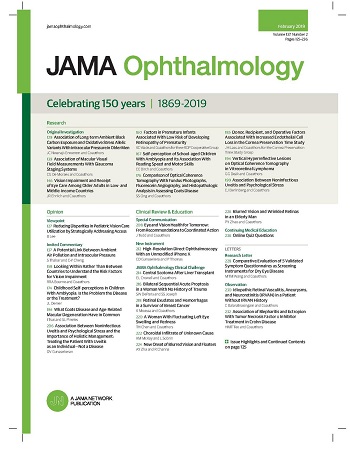眼底屈光偏移作为个体化近视的生物标志物
IF 7.8
1区 医学
Q1 OPHTHALMOLOGY
引用次数: 0
摘要
作为轴上指标,球面等效折射(SER)和轴向长度(AL)在捕捉个体水平的后节解剖差异方面受到限制。目的提出眼底度规-眼底折射偏移量(FRO),并探讨其与光学相干断层扫描(OCT)所得眼部参数的关系。设计、环境和参与者本横断面、基于人群的研究使用了来自英国生物银行(2009-2010)的45180只健康眼睛的数据。来自随机子集(70%)的眼底照片用于训练深度学习模型来预测SER,其目标是开发一个学习捕捉眼底外观从- 15.50 D到9.25 D的非病理性变化的模型。将训练好的模型应用于剩余子集(内部未见集)以获得每只眼睛的FRO。还对152只右眼的外部数据集(Caledonian队列,2023-2024)进行了FRO计算,该数据集具有增强的深度成像OCT和AL数据。数据分析时间为2024年7月至11月。曝光率,定义为眼底预测SER的误差。更为阴性的FRO表明,与具有相同SER的眼睛相比,眼底看起来更近视。在控制SER、年龄、性别和种族的情况下,使用内部未见集的线性混合效应回归检验FRO和黄斑厚度(MT)之间的关联。在外部数据集中,使用线性固定效应回归检验了FRO与脉络膜面积、脉络膜血管指数(CVI)和MT的关联,控制了SER(以及随后的AL)和其他上述协变量。结果在平均(SD)年龄分别为54.5(8.2)岁和19.3(3.8)岁的个体中,内部未见集中9524只眼睛和外部数据集中152只眼睛获得了高质量的OCT数据。在内部未见组中,较负的FRO与较低的MT独立相关(β, 0.64;95% ci, 0.37-0.90;P, amp;肝移植;措施)。在外部数据中也观察到类似的关联——无论是否根据SER进行调整(β, 2.45;95% ci, 0.64-4.26;P = 0.008)或AL (β, 2.09;95% ci, 0.28-3.91;P = .02)。此外,在ser调整后,CVI随着FRO变得更负而下降(β, 0.01;95% ci, 0.01-0.02;P, amp;肝移植;.001)和经al校正(β, 0.01, 95% CI, 0.004-0.02;P = .001)分析。本研究中,FRO反映了个体水平上SER(或AL)与屈光不正解剖严重程度之间的不匹配。这可能与近视及其并发症的个性化风险预测具有预后相关性。本文章由计算机程序翻译,如有差异,请以英文原文为准。
Fundus Refraction Offset as an Individualized Myopia Biomarker
ImportanceAs on-axis metrics, spherical equivalent refraction (SER) and axial length (AL) are limited in capturing individual-level differences in posterior segment anatomy.ObjectiveTo propose a fundus-level metric—fundus refraction offset (FRO)—and investigate its association with ocular parameters derived from optical coherence tomography (OCT).Design, Setting, and ParticipantsThis cross-sectional, population-based study used data from 45 180 healthy eyes in the UK Biobank (2009-2010). Fundus photographs from a random subset (70%) were used to train a deep learning model to predict SER, with the goal of developing a model that learned to capture the nonpathological variations in fundus appearance from −15.50 D to 9.25 D. The trained model was applied to the remaining subset (internal unseen set) to derive FRO for each eye. FRO was also computed for an external dataset (the Caledonian cohort, 2023-2024) with enhanced depth imaging OCT and AL data for 152 right eyes. Data were analyzed from July to November 2024.ExposureFRO, defined as the error in fundus-predicted SER. A more negative FRO indicated a more myopic-looking fundus than typical for an eye with the same SER.Main Outcomes and MeasuresThe association between FRO and macular thickness (MT) was tested using linear mixed-effects regression in the internal unseen set, controlling for SER, age, sex, and race. In the external dataset, the associations of FRO with choroidal area, choroidal vascularity index (CVI), and MT were examined using linear fixed-effects regression, controlling for SER (and subsequently AL) and other aforementioned covariates.ResultsHigh-quality OCT data were available from 9524 eyes in the internal unseen set and 152 eyes in the external dataset among individuals with a mean (SD) age of 54.5 (8.2) years and 19.3 (3.8) years, respectively. In the internal unseen set, a more negative FRO was independently associated with lower MT (β, 0.64; 95% CI, 0.37-0.90; P < .001). A similar association was observed in the external dataset—whether adjusted for SER (β, 2.45; 95% CI, 0.64-4.26; P = .008) or AL (β, 2.09; 95% CI, 0.28-3.91; P = .02). Additionally, CVI decreased as FRO became more negative—both in the SER-adjusted (β, 0.01; 95% CI, 0.01-0.02; P < .001) and AL-adjusted (β, 0.01, 95% CI, 0.004-0.02; P = .001) analyses.Conclusion and RelevanceIn this study, FRO reflected the individual-level mismatch between SER (or AL) and the anatomical severity of ametropia. This may have prognostic relevance for personalized risk prediction of myopia and its complications.
求助全文
通过发布文献求助,成功后即可免费获取论文全文。
去求助
来源期刊

JAMA ophthalmology
OPHTHALMOLOGY-
CiteScore
13.20
自引率
3.70%
发文量
340
期刊介绍:
JAMA Ophthalmology, with a rich history of continuous publication since 1869, stands as a distinguished international, peer-reviewed journal dedicated to ophthalmology and visual science. In 2019, the journal proudly commemorated 150 years of uninterrupted service to the field. As a member of the esteemed JAMA Network, a consortium renowned for its peer-reviewed general medical and specialty publications, JAMA Ophthalmology upholds the highest standards of excellence in disseminating cutting-edge research and insights. Join us in celebrating our legacy and advancing the frontiers of ophthalmology and visual science.
 求助内容:
求助内容: 应助结果提醒方式:
应助结果提醒方式:


